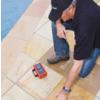
Floor Safety Inspection Slippery Floors
Employers and property owners are legally obligated to provide a safe working environment for employees and guests. One of the most common accidents are ‘slip and fall’ incidents. With increased emphasis on workplace and home safety in recent times, it is essential that property owners address any floor safety concerns to avoid the personal and financial consequences of slip and fall accidents.
‘Slip and fall’ accidents are usually a direct result of unsafe floor surfaces. Floors become slippery for a number of reasons and it is essential that employers have periodic floor safety assessments carried out by fully trained floor safety experts who inspect the premises, measure the slip resistance of floor surfaces and identify critical risks to pedestrians.
The most common cause of ‘slip and fall’ accidents is a lack of slip resistance. This lack of slip resistance can be attributed to a number of factors:
Inappropriate choice of flooring – Require slip resistance is directly related to how the area is used. For example, a tile used in a wet area such as restrooms, kitchens and foyers (where water is tracked) will need to be much more slip resistant than that chosen for an area that is not exposed to water or other liquids. Likewise, sloping floors require increase slip resistance to protect pedestrians.
Wear and tear of the flooring – Often a floor will have adequate slip resistance when it is installed but, over time due to constant wear and tear, it becomes ‘polished’ from constant foot traffic its slip resistance is diminished.
Incorrect floor treatments – When floors are sealed, the sealer fills in the pores of the tile which are designed to provide slip resistance. Likewise, non-slip or anti-slip coatings are short term, ineffective, treatments for enhancing slip resistance. Like sealers, they ‘fill’ the existing pore structure of the tile, stone, concrete or other stone-based surface and rely on an abrasive material to the final coat to increase slip resistance. Quickly, the abrasive material added to the coating wears away to leave a very slippery and dangerous coating. The difficulty and expense of removing sealers and non-slip / anti-slip coatings is substantial.
Improper Cleaning Regime – Regardless of how slip resistant a floor is when it is installed, if floors are incorrectly maintained the floor’s surface pores become clogged and slip resistance will decrease dramatically. Mopping of floors is probably the least efficient way to retain slip resistance. Mops are dirty and unhygienic – dirt and other foreign material on the floor is, in effect, simply spread around and gradually forced into the naturally porous material, once again creating a dangerous pedestrian environment.
Grip Guard Floor Safety personnel are fully trained floor safety experts who provide advice in the follow areas:
- Assistance with flooring selection to ensure that the most appropriate non-slip / anti-slip surface is chosen in view of how the area is to be used.
- Floor Safety Inspections to determine the inherent risks of the pedestrian areas and provide slip resistance testing and reporting.
- Floor Safety Advice to provide property owners and employers with the most up to date information and advice should the floor area fail to meet safety expectations.
- Non-Slip / Anti-Slip Floor Safety Solutions custom designed for each type of floor treatment and use including Grip Guard anti-slip floor safety treatment, non-slip tapes, safety stair nosings, R-12 marine grade safety flooring, and tactiles for the visually impaired.
- Safety-Clean Floor Safety Management including periodic deep penetration cleaning of the floor to remove foreign materials from the pores of the floor surface that interfere with slip resistance.
